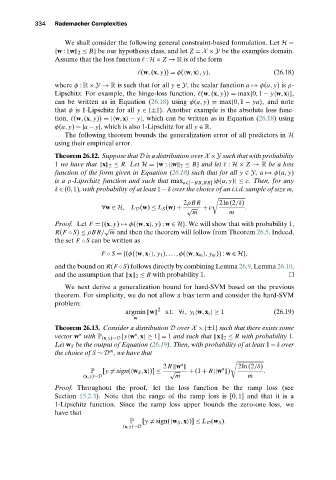Page 352 - Understanding Machine Learning
P. 352
Rademacher Complexities
334
We shall consider the following general constraint-based formulation. Let H =
{w : w 2 ≤ B} be our hypothesis class, and let Z = X × Y be the examples domain.
Assume that the loss function : H × Z → R is of the form
(w,(x, y)) = φ( w,x , y), (26.18)
where φ : R × Y → R is such that for all y ∈ Y, the scalar function a → φ(a, y)is ρ-
Lipschitz. For example, the hinge-loss function, (w,(x, y)) = max{0,1 − y w,x },
can be written as in Equation (26.18)using φ(a, y) = max{0,1 − ya}, and note
that φ is 1-Lipschitz for all y ∈{±1}. Another example is the absolute loss func-
tion, (w,(x, y)) =| w,x − y|, which can be written as in Equation (26.18)using
φ(a, y) =|a − y|, which is also 1-Lipschitz for all y ∈ R.
The following theorem bounds the generalization error of all predictors in H
using their empirical error.
Theorem 26.12. Suppose that D is a distribution over X ×Y such that with probability
1 we have that x 2 ≤ R.Let H ={w : w 2 ≤ B} and let : H × Z → R be a loss
function of the form given in Equation (26.18) such that for all y ∈ Y, a → φ(a, y)
is a ρ-Lipschitz function and such that max a∈[−BR,BR] |φ(a, y)|≤ c. Then, for any
δ ∈ (0,1), with probability of at least 1−δ over the choice of an i.i.d. sample of size m,
2ρBR 2ln(2/δ)
∀w ∈ H, L D (w) ≤ L S (w) + √ + c .
m m
Proof. Let F ={(x, y) → φ( w,x , y): w ∈ H}. We will show that with probability 1,
√
R(F ◦ S) ≤ ρBR/ m and then the theorem will follow from Theorem 26.5. Indeed,
the set F ◦ S canbe writtenas
F ◦ S ={(φ( w,x 1 , y 1 ),...,φ( w,x m , y m )) : w ∈ H},
and the bound on R(F ◦S) follows directly by combining Lemma 26.9, Lemma 26.10,
and the assumption that x 2 ≤ R with probability 1.
We next derive a generalization bound for hard-SVM based on the previous
theorem. For simplicity, we do not allow a bias term and consider the hard-SVM
problem:
2
argmin w s.t. ∀i, y i w,x i ≥ 1 (26.19)
w
Theorem 26.13. Consider a distribution D over X ×{±1} such that there exists some
vector w with P (x,y)∼D [y w ,x ≥ 1] = 1 and such that x 2 ≤ R with probability 1.
Let w S be the output of Equation (26.19). Then, with probability of at least 1 −δ over
m
the choice of S ∼ D , we have that
2 R w 2ln(2/δ)
P [y = sign( w S ,x )] ≤ √ + (1 + R w ) .
m m
(x,y)∼D
Proof. Throughout the proof, let the loss function be the ramp loss (see
Section 15.2.3). Note that the range of the ramp loss is [0,1] and that it is a
1-Lipschitz function. Since the ramp loss upper bounds the zero-one loss, we
have that
P [y = sign( w S ,x )] ≤ L D (w S ).
(x,y)∼D

